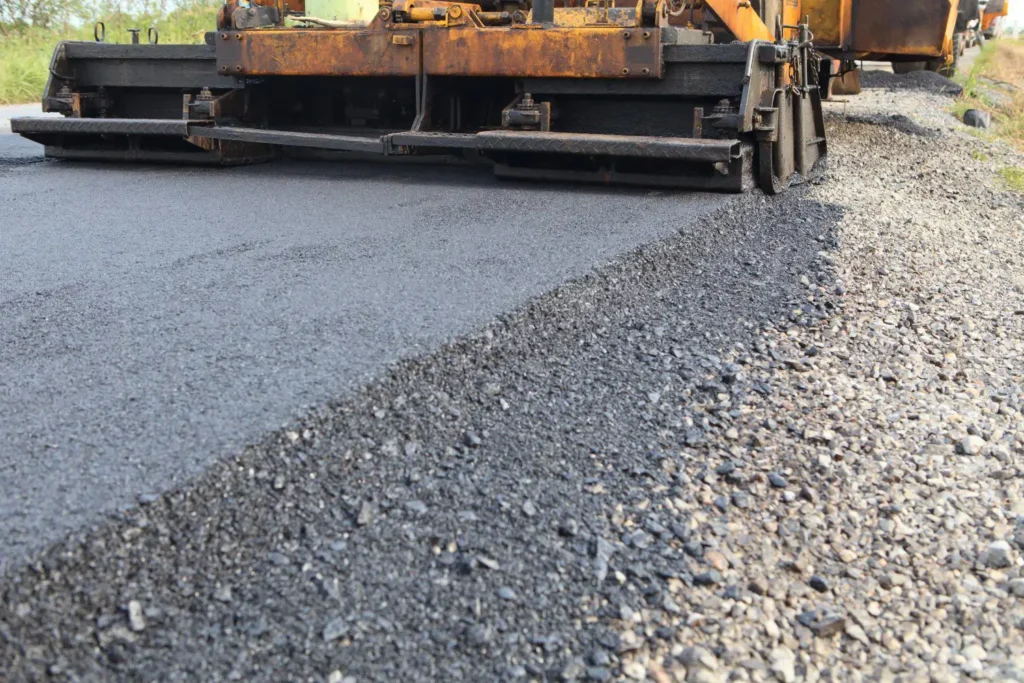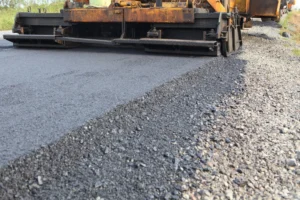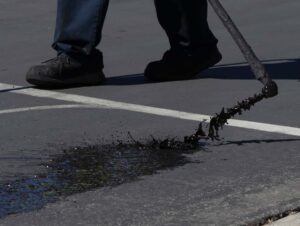Asphalt paving is a worthwhile investment, but it’s only as reliable as the care it receives. Without regular asphalt maintenance, your pavement can quickly fall victim to cracks, potholes, and other damage caused by weather, heavy traffic, and age.
Luckily, there are many preventative measures you can take to protect the lifespan of your surface and offset costly repairs.
In this guide, we’ll share key asphalt maintenance tips to protect your commercial parking lots, roadways, and more. These tips will help you spot and address issues early, reduce repair costs, and keep your pavement durable for years.
Why Is Asphalt Maintenance Important?
Asphalt surfaces are constantly exposed to harsh conditions such as sun, rain, freezing weather, and heavy traffic. Over time, these factors cause the pavement to deteriorate.
Regular pavement maintenance helps slow down the damage caused by normal wear and tear. Fixing small problems early, like filling cracks and applying sealcoat, can add 5 to 10 years or more to the lifespan of your pavement.
Preventative care also protects your investment by lowering safety risks, improving the look of your property, and preventing expensive downtime. Simply put, spending a little on maintenance now can save you a lot of money later.
Why Is Asphalt Maintenance Important?
Asphalt faces many challenges that can cause it to wear down faster than expected. Weather changes, heavy traffic, and other factors can dry out, crack, or weaken the surface. Over time, this leads to costly and potentially dangerous cracks, potholes, and structural damage.
Knowing the common causes of pavement deterioration helps you identify issues early, which allows for timely asphalt repair and upkeep.
Here are the most frequent reasons why asphalt breaks down:
- Water infiltration and poor drainage
Water that gets into cracks or stays on the surface can weaken the layers under the asphalt. If water doesn’t drain properly, it can cause the pavement to sink and crack. - UV rays and oxidation
The sun’s rays dry out asphalt and make it brittle. This causes cracks and makes the pavement more vulnerable to damage from traffic and weather. - Freeze-thaw cycles
In cold places, water under the pavement freezes and expands. This puts pressure on the asphalt and causes cracks. When the ice melts, more water gets in, making the damage worse. - Oil and chemical spills
Fuel, oil, and other chemicals can break down the asphalt and soften the surface. This leads to ruts and potholes. - Heavy vehicle loads and traffic wear
Heavy trucks and machinery put a lot of pressure on the pavement. Over time, this wears down the surface and can cause serious damage if not fixed.
Understanding these causes helps you prioritize repairs and asphalt maintenance before problems get worse.
6 Key Asphalt Maintenance Practices
Extending the life of your lot or roadway starts with following these essential pavement maintenance practices. By taking these steps and working with experienced professionals like PKS Paving, you can protect your investment, avoid costly repairs, and keep your commercial surfaces safe and durable for years to come.
- Regular Inspections
Routine visual checks help catch small cracks, drainage problems, or surface wear before they get worse. Finding issues early means you can fix them quickly, saving time and money by avoiding bigger repairs down the line. - Crack Filling
Filling cracks with the right material stops water from seeping underneath and damaging the base layers. Crack filling is a cost-effective way to prevent cracks from growing and turning into bigger problems, such as potholes. - Sealcoating
Sealcoating is applied to refresh and protect it from damage caused by UV rays, oxidation, and harsh weather. It helps prevent the surface from drying out and cracking, extending the pavement’s lifespan. - Pothole Repair
Potholes can be dangerous for vehicles and pedestrians alike. Professionals use long-lasting pothole patching methods to repair them and restore a smooth, safe surface. - Proper Drainage
Proper drainage keeps water moving away from your pavement to prevent seepage that causes damage. Regularly clearing drains and maintaining slopes helps keep your asphalt dry and strong. - Striping & Repainting
Clear, visible markings improve safety and traffic flow in parking lots, fire lanes, and access roads. Repainting faded stripes is a key component of asphalt parking lot maintenance, protecting the pavement beneath and giving your surface a clean, professional look.
Following these maintenance steps will help you avoid costly repairs, protecting your property and its value over time.
Maintenance Schedule Recommendations
A consistent pavement maintenance schedule helps you stay on top of regular checkups and repairs. You can catch small problems early and avoid expensive fixes down the road. This approach ensures your asphalt pavement remains durable, safe, and visually appealing for years to come.
Here’s a simple guideline to follow for commercial asphalt surfaces:
- Monthly: Visual Inspections
Inspect surfaces monthly for new cracks and standing water, as these are visible signs of asphalt damage. Early detection helps you seek professional maintenance to avoid larger repairs. - Annually: Minor Crack Sealing
Schedule crack filling once a year to prevent small cracks from growing into larger issues. This lessens the risk of moisture damage to the base layers. - Every 2–3 Years: Sealcoating
Applying sealcoat every few years rejuvenates the asphalt surface, protects against UV damage, and slows oxidation and cracking. - As Needed: Pothole Repair & Repainting
Professional long-lasting repairs keep the area safe and prevent more damage. Repainting faded lines and markings also keeps traffic clear and organized.
DIY vs Professional Asphalt Maintenance
Knowing what’s safe to do yourself and when to call the pros helps keep your asphalt safe, effective, and built to last. It’s the best way to avoid major issues and keep your property running smoothly.
What property owners can do themselves:
- Sweeping and debris removal keep surfaces clean and prevent clogged drains. This simple task also helps reduce surface wear over time.
- Monitoring surface conditions regularly helps spot early signs of damage like cracks, pooling water, or small potholes, enabling you to schedule repairs before they get worse.
When to hire professionals:
- Pothole repair should be done by experienced crews using proper tools and expertise to keep your pavement strong.
- Sealcoating requires the right tools and know-how to apply an even coat that protects against sun, oxidation, and weather damage.
- Crack filling may seem easy, but professionals make sure the filler seals cracks fully to keep water out.
- Fixing drainage issues and performing overlays are complicated jobs that require the expertise of professionals to keep your pavement stable and safe.
Hiring a professional asphalt company like PKS Paving ensures expert advice, quality work, and lasting results that protect your investment.
Extend the Life of Your Asphalt With Preventative Maintenance
When you need professional asphalt maintenance, PKS Paving has you covered. Our team specializes in keeping your parking lots, walkways, and access roads safe, durable, and long-lasting.
With regular inspections, expert crack sealing, sealcoating, and pothole repair, we help extend the life of your asphalt and reduce downtime. Our pavement maintenance plans are tailored to your property and backed by years of hands-on experience.
Get in touch with PKS Paving and build a smarter maintenance plan to extend the life of your pavement.




